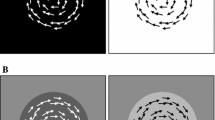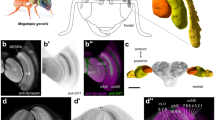Summary
-
1.
A glass microelectrode was inserted into the unit responding to movements of a spot in the lobula or, on rare occasions, in the medulla of the optic lobe of fleshflies (Boettcherisca peregrina).
-
2.
By the sequential presentation of several or two stationary spots placed along the preferred-null axis of the directionally selective unit and by the turning on and off of a stationary spot (test stimulus) placed along the preferred-null axis at various distances from another continuously lighted, fixed spot (conditioned stimulus), it is demonstrated that spatial, excitatory effects were produced on the preferred direction side of the conditioned spot, and simultaneously, spatial, inhibitory effects were seen on the side of the null direction. Therefore, it is considered that movement perception is analyzed on the basis of the stationary and elemental light sensation and is completed by both the mechanism of excitation in the preferred direction and inhibition in the null direction.
-
3.
The field with excitatory effect is relatively wider (20 ° or more in visual angle) than that with inhibitory one (8 °–20 °, rarely more than 20 °). The inhibitory effect decreases gradually with increasing distance from the conditioned spot stimulus, while the excitatory effect increases with each 5 ° of separation in visual angle from the conditioned spot. Therefore, it is assumed that the neural mechanism for excitatory effects is different from that for inhibitory effects.
-
4.
Movements of a bright slit on a dark background and a dark slit on a light background were given using various slit lengths. The discharge rate in the directionally selective unit shows an increase, a decrease or an increase after a decrease by increasing the length of the slit. These three kinds of responses are explained by the width of the interactivity between the excitatory and inhibitory fields to spot stimulation.
-
5.
The neural organization of excitatory and inhibitory field effects underlying the directional selectivity in movement perception is discussed from the morphological view point.
Similar content being viewed by others
References
Arnett, D. W.: Receptive field organization of units in the first optic ganglion of Diptera. Science173, 929–931 (1971).
Barlow, H. B., Levick, W. R.: The mechanism of directionally selective units in rabbit's retina. J. Physiol. (Lond.)178, 477–504 (1965).
Bishop, L. G., Keehn, D. G.: Neural correlates of the optomotor response in the fly. Kybernetik3, 288–295 (1967).
Bishop, L. G., Keehn, D. G., McCann, G. D.: Motion detection by interneurons of optic lobes and brain of the fliesCalliphora phaenicia andMusca domestica. J. Neurophysiol.31, 509–525 (1968).
Braitenberg, V.: Unsymmetrische Projektion der Retinulazellen auf die Lamina ganglionaris bei der FliegeMusca domestica. Z. vergl. Physiol.50, 212–214 (1966).
Braitenberg, V.: Patterns of projection in the visual system of the fly. I. Retinalamina projections. Exp. Brain Res.3, 271–298 (1967).
Cajal S., Ramón Y., Sánchez, D.: Contribución al conocimento de los centros nerviosos de los insectos. Trab. Lab. Invest. biol. Univ. Madrid13, 1–164 (1915). Cited from Bullock, T. H., Horridge, G. A.: Structure and function in the nervous systems of invertebrates, vol. II. San Francisco and London: W. H. Freeman and Co. 1965.
Collet, A. D., Blest, J.: Binocular directionally sensitive neurones, possibly involved in optomotor response of locusts. Nature (Lond.)212, 1330–1333 (1966).
Hartline, H. K., Ratliff, F.: Inhibitory interaction of receptor units in the eye ofLimulus. J. gen. Physiol.40, 357–376 (1956).
Horridge, G. A., Meinertzhagen, I. A.: The exact neural projection of the visual fields upon the first and second ganglia of the insect eye. Z. vergl. Physiol.66, 369–378 (1970).
Horridge, G. A., Scholes, J. H., Shaw, S., Tunstall, J.: Extracellular recordings from single neurones in the optic lobe and brain of the locust. In: The physiology of the insect central nervous system, p. 165–202, eds. J. E. Treherne and J. W. L. Beament. London: Academic Press Inc. Ltd. 1965.
Hubel, D. H., Wiesel, T. N.: Receptive fields and functional architecture in two nonstriate visual area (18 and 19) of the cat. J. Neurophysiol.28, 229–289 (1965).
Kirschfeld, K.: Die Projektion der optischen Umwelt auf das Raster derRhabdomere im Komplexauge vonMusca. Exp. Brain Res.3, 248–270 (1967).
Laughlin, S. B., Horridge, G. A.: Angular sensitivity of the retinula cells of darkadapted worker bee. Z. vergl. Physiol.74, 329–335 (1971).
Maturana, H. R., Frenk, S.: Directional movement and horizontal edge detectors in pigeon retina. Science142, 977–979 (1963).
McCann, G. D., Dill, J. C.: Fundamental properties of intensity, form, and motion perception in the visual nervous systems ofCalliphora phaenicia andMusca domestica. J. gen. Physiol.53, 385–413 (1969).
Michael, C. R.: Receptive fields of single optic nerve fibers in a mammal with an all-cone retina. II: Directionally selective units. J. Neurophysiol.31, 257–267 (1968).
Mimura, K.: Movement discrimination by the visual system of flies. Z. vergl. Physiol.73, 105–138 (1971).
Naka, K. I.: Receptive field mechanism in the vertebrate retina. Science171, 691–693 (1971).
Norton, A. L., Spekreijse, H., Wagner, H. G., Wolbarsht, M. L.: Response to directional stimuli in retinal preganglionic units. J. Physiol. (Lond.)206, 93–107 (1970).
Seitz, G.: Bau und Funktion des Komplexauges der Schmeißfliege. Naturwissenschaften58, 258–265 (1971).
Strausfeld, N. J.: The organization of the insect visual system (Light microscopy). I. Projections and arrangements of neurons in the Lamina ganglionaris of Diptera. Z. Zellforsch.121, 377–441 (1971).
Tominaga, Y., Kuwabara, M.: “Horizontal cell” in Lamina ganglionaris of the fly. Zool. Mag.80, 412–413 (1971) (in Japanese).
Trujillo-Cenóz, O.: Some aspects of the structural organization of the medulla in muscoid flies. J. Ultrastruct. Res.27, 533–553 (1969).
Vowles, D. M.: The receptive fields of cells in the retina of the housefly (Musca domestica). Proc. roy. Soc. B164, 552–576 (1966).
Zettler, P., Järvilehto, M.: Histologische Lokalisation der Ableitelektrode. Belichtungspotentiale aus Retina und Lamina beiCalliphora. Z. vergl. Physiol.68, 202–210 (1970).
Author information
Authors and Affiliations
Additional information
This study was supported in part by a grant from the Education Ministry of Japan.
I wish to express my gratitude to Prof. M. Kuwabara and Dr. H. Tateda, Department of Biology, Faculty of Sciences, Kyushu University, for their support and very helpful discussions in this work. I especially wish to thank Drs. Y. Toh and K. Morimoto of the same Department for their help in breeding the fly.
Rights and permissions
About this article
Cite this article
Mimura, K. Neural mechanisms, subserving directional selectivity of movement in the optic lobe of the fly. J. Comp. Physiol. 80, 409–437 (1972). https://doi.org/10.1007/BF00696437
Received:
Issue Date:
DOI: https://doi.org/10.1007/BF00696437




